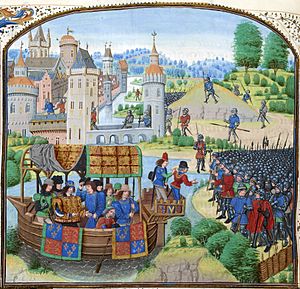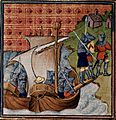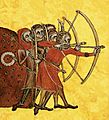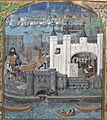Peasants' Revolt facts for kids
Quick facts for kids Peasants' Revolt |
|||||||
|---|---|---|---|---|---|---|---|
 Richard II meets the rebels on 13 June 1381 in a miniature from a 1470's copy of Jean Froissart's Chronicles. |
|||||||
|
|||||||
| Belligerents | |||||||
| Rebel forces | Royal government | ||||||
| Commanders and leaders | |||||||
| Wat Tyler John Wrawe John Ball William Grindecobbe |
Richard II William Walworth Henry le Despenser |
||||||
| Casualties and losses | |||||||
| At least 1,500 | Unknown | ||||||
The Peasants' Revolt was a huge uprising by ordinary people in England in 1381. It was the biggest rebellion of farmers and workers in medieval England. It is also known as Wat Tyler's Rebellion (named after one of its leaders) or the Great Rising.
People are not completely sure why the revolt started, but there were several big reasons:
- A terrible sickness called the Black Death had swept through Europe from 1347 to 1353. It killed many people, which meant there were fewer workers. This caused big problems for the country's economy (how money and goods are made and used).
- To pay for a long war called the Hundred Years' War, the English king kept asking people to pay more and more taxes. This made many people very angry.
- The government in London was not very strong at the time. This made it harder for them to control the country.
Contents
Life for Peasants in Medieval England
Most people in medieval England were peasants. There were two main types: serfs and free peasants.
Serfs: Life Under Control
Serfs were not truly free. They were tied to the land they worked on, which belonged to a lord (a powerful landowner). They had to work for the lord, often for free, and needed his permission for many things, like getting married. Serfs had very little food and few belongings. They lived in simple houses, often sharing space with their animals. Knights, who were soldiers, were supposed to protect them.
Free Peasants: A Little More Freedom
Free peasants had a bit more freedom than serfs, but they still had a tough life. They had to pay rent to live on their land and paid for many other things, like collecting water. Even though they were called "free," they were still controlled by the higher classes and had less than almost everyone else, except for the serfs.
Key Events of the Revolt
The Peasants' Revolt happened very quickly. Here are the main events:
- May 30th: The trouble started when peasants in Essex chased away a tax collector named Thomas Bampton from their village.
- June 1st: The revolt quickly spread across Essex, Hertfordshire, and Suffolk. More and more people joined in.
- June 7th: The rebels took over Maidstone and Rochester castles, showing how strong they were becoming.
- June 10th: A new leader, Wat Tyler, appeared. He was a skilled speaker and fighter. The rebels from Kent and Essex started marching towards London. They wanted to tell the king their problems, but Wat Tyler had a plan to attack the city. King Richard II of England was very surprised and had only a few hundred soldiers in London.
- June 13th: Wat Tyler's rebels entered London. They killed many lawyers, who were seen as part of the unfair system. Most of London was not destroyed, but there was a lot of fear. King Richard agreed to meet the rebels at a place called Mile End.
- June 14th: King Richard met with Wat Tyler. Tyler told the king all the peasants' demands, and the king agreed to them! Meanwhile, another group of rebels went to the Tower of London. They found some of the people they hated most, like Simon Sudbury and Robert Hailes, and killed them.
- June 15th: Wat Tyler wanted to meet the king again to ask for even more. When they met, Wat Tyler was killed. It's not completely clear how it happened. After Tyler's death, King Richard ordered his soldiers to attack the rebels. Over a thousand rebels were killed.
Even though the revolt ended with many rebels being killed, some of Wat Tyler's demands were put into place by the king about 50 years later. The revolt showed the powerful people that ordinary people could fight back against unfair rules.
Images for kids
-
English soldiers landing in Normandy, around 1380–1400, during the Hundred Years' War.
-
A picture from the late 15th century showing the Tower of London and its main building, the White Tower.
-
The Abbey Gate of Bury St Edmunds Abbey, which the rebels attacked on June 13.
-
Corpus Christi College's Old Court, attacked by the rebels on June 15.
-
An illustration from Vox Clamantis by John Gower, a poem that described and criticized the Revolt, in Glasgow University Library.
-
A 14th-century carving of Henry Despenser, who won the Battle of North Walsham in Norfolk.
-
A portrait from the late 14th century of Richard II in Westminster Abbey.
-
A 14th-century scene of a reeve (a local official) telling serfs what to do, from the Queen Mary Psalter. British Library, London.
-
Historian William Stubbs, who thought the revolt was "one of the most important events in all of our history," painted by Hubert von Herkomer.
See also
 In Spanish: Rebelión de Wat Tyler para niños
In Spanish: Rebelión de Wat Tyler para niños













